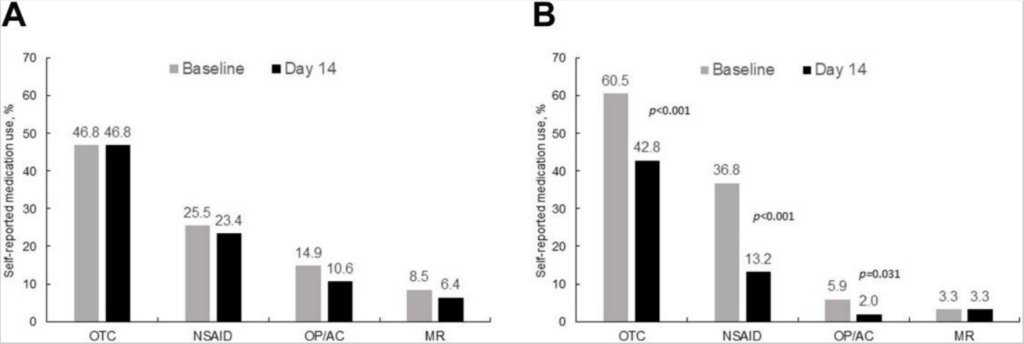Type of Painkillers: Your Guide To Choosing The Right Ones
Last updated on : 07 Feb, 2025
Read time : 8 min
One of The popular methods of treating pain at home is taking pain relief tablets. We often use OTC painkiller tablets as soon as we feel uncomfortable or distressed. We may think we know painkillers and how they work, but are we sure?
Let’s read further about the mode of action and side effects of painkillers.
Types of OTC painkillers
The most commonly used over-the-counter painkillers are-
1. Paracetamol
Paracetamol is a pain-relieving medicine you can rely on. It’s used to treat menstruation discomfort, fever, tooth pain, back pain, headaches, and body pain. It is often effective for minor pains. It’s one of the pregnancy-safe drugs. But, its overdose can damage the liver, giving rise to a situation known as Hepatotoxicity.
Painkillers under this category – Acetaminophen, Calpol, Panadol, etc.
a) Paracetamol mode of action
Paracetamol can block the cyclooxygenase pathways and is frequently grouped with NSAIDs (nonsteroidal anti-inflammatory medicines). It is known to have central effects that eventually lessen the sensations of pain. Acetaminophen’s antipyretic effects are most likely due to its direct impact on the brain’s heat-regulating areas, which causes peripheral vasodilation, sweating, and a loss of body heat. Additional read- how to reduce body heat.
b) Side effects of Paracetamol
When you take Paracetamol, you should be aware that you may experience side effects like nausea, dizziness, and headaches. If these problems persist or get worse, stop taking medicine immediately and consult your doctor.
c) Things to consider
Fortunately, there aren’t many recorded clinically relevant medication interactions with Paracetamol. Due to differences between observational studies and those conducted on healthy volunteers, there is a great deal of debate over the potential interaction between warfarin (By using warfarin, blood clots in your blood and blood vessels are prevented from forming or growing larger) and its ability to boost its anticoagulant effects. Other than that, no significant medication interactions with therapeutic doses of paracetamol in humans have been confirmed.
2) Non-steroidal inflammatory drugs
Non-steroidal inflammatory drugs (NSAIDs) are painkillers that reduce inflammation (swelling) and pain, such as those used to treat arthritis. As the name suggests, they do not contain steroids.
Painkillers under this category– Ibuprofen, Naproxen, Diclofenac, Mefenamic acid, and Aspirin for pain relief (low-dose aspirin is not normally considered to be an NSAID).
a) NSAIDs mode of action
Nonsteroidal anti-inflammatory medications (NSAIDs) have historically been used to treat pain by inhibiting the production of prostaglandin-producing enzymes.
NSAIDs act as analgesics (pain killers) through a range of peripheral and central mechanisms, in addition to peripheral suppression of prostaglandin synthesis.
b) Side effects of NSAIDs
Currently, GI issues (Gastrointestinal), renal issues (Kidneys), and Cardiovascular (Heart-related) events are the most common NSAID adverse effects. All NSAIDs are not equally likely to cause renal and cardiovascular adverse effects, contrary to a widespread assumption.
c) Things to Consider
When aspirin, alcohol, some antihypertensives (Blood pressure medicines), antidepressants, and other frequently taken drugs are taken with NSAIDs, drug interactions have been documented. Healthcare professionals can help patients understand the importance of balancing efficacy and safety by advising them to use over-the-counter NSAIDs at the lowest effective dose for the shortest time possible.
Read more– Ayurvedic medicinal herbs to control hypertension
3) Opioids
Opioids are the most common pain medications prescribed for chronic pain. These painkillers have a solid composition. Opioids on prescription are permitted to treat moderate to severe pain. This might include certain intense pain types (sudden and short-term), cancer-related discomfort, and post-surgery discomfort. Some opioids inhibit gastric motility, the mechanism by which food passes through your digestive tract by a sequence of muscular contractions, which is used to control diarrhea.
Pain killers under this category– Morphine, Codeine, Methadone, Tramadol, etc.
a) Opioid’s mode of action
Opioid receptors, when turned on, set off a series of chemical processes that eventually control how pain signals are transmitted.
b) Side effects of Opioids
While opioids are sometimes used to treat pain, they can also lead to dependence and even overdose. The risk of opioid abuse and overdose is highest among people who misuse prescription opioids or take them in combination with other drugs or alcohol. Opioids frequently cause drowsiness (sedation), dizziness, nausea and vomiting, and constipation.
c) Things to consider
Opioids and other medications that have calming or sleep-inducing effects or pain-relieving effects may interact additively and increase the effectiveness of opioids which may be of concern.
A survey was conducted between a control group (CG) and a treatment group (TG), in which patients indicated the type of pain relief medication they were using, such as over-the-counter pain medications, prescription anti-inflammatory medications, opioids or anticonvulsants, or muscle relaxants.
- At baseline, Ibuprofen was the most commonly reported OTC pain medication (38.3% in the CG and 41.4% in the TG).
- Acetaminophen was the second most frequently used OTC pain medication, with 19.1% of CG and 17.7% of TG using it.
- The most frequently reported anti-inflammatory prescription medication was diclofenac (CG=19.1%, TG=19.1%).
- Naproxen was the second most commonly prescribed medication (CG = 2.1%, TG = 7.5%).

Percent using each type of pain medication at baseline and day 14 within the control (A), and treatment (B) groups.
Abbreviations: OTC, over-the-counter; NSAID, nonsteroidal anti-inflammatory drug; OP, opioid; AC, anticonvulsant; MR, muscle relaxant.
- In some cases, opioids may be the best way to treat acute pain, but there are ways to cut back on opioid use with over-the-counter (OTC) medications that work just as well on their own or in combination.
- Several over-the-counter pain relievers are easy to get and don’t cost much
- The American Headache Society says that OTC NSAIDs and combination medications like acetaminophen, aspirin, and caffeine are Level A recommendations for reducing migraine pain and other symptoms.
- Nonsteroidal anti-inflammatory drugs (NSAIDs), combination analgesics, and acetaminophen are examples of OTC medications with well-established safety profiles that do not have the same dependence potential as opioids.
- NSAIDs can cause gastrointestinal problems, renal toxicity, and blood pressure elevation, among other risks and side effects. Additionally, they are affordable and easily accessible in a pharmacy setting.
Conclusion
Getting painkillers is easy. But knowing the right dosage and type of painkiller is very important. No matter what your pain is, it’s crucial to understand how your medications work and put them into perspective. It’s always advisable to consult your healthcare practitioner before consuming OTC painkillers. You can avail of branded as well as generic medicines by uploading your prescription on the Truemeds app. When placing an order for medications online, you may save money by selecting an alternative or generic medicine advised by Truemed’s expert doctors. You can save up to 72% on your purchase and get *free home delivery pan India.
Disclaimer – The information presented here should not be used to diagnose or treat any medical conditions, nor should it be used in a medical emergency. A qualified medical professional should be consulted to diagnose and treat all medical conditions.
Frequently Asked Questions (FAQs)
Abuse of painkiller medicine over a long period can result in major side effects such as heart-related problems, and liver and kidney issues. It can also cause intestinal blockages, hemorrhoids, abdominal bloating, constipation, and abdominal distention.
Since acetaminophen doesn’t induce adverse effects like stomach pain and bleeding, it is typically seen as being safer than other non-opioid painkillers. Also, it’s safe during pregnancy.
Since NSAIDs (non-steroidal anti-inflammatory medicines) like ibuprofen and aspirin might irritate the stomach lining, it is recommended to take them with food or a glass of milk. It won’t matter if you haven’t eaten because paracetamol doesn’t irritate the stomach lining.
Some OTC NSAIDs are aspirin, naproxen (Aleve), and ibuprofen (Advil, Motrin). If over-the-counter painkillers don’t help, your doctor may give you something stronger. There are also stronger prescription doses of many NSAIDs. Opioids are the painkillers that work the best.
References:-
- Prescription Opioids DrugFacts | National Institute on Drug Abuse. (2021, June 1). National Institute on Drug Abuse. Retrieved January 4, 2023, from https://nida.nih.gov/publications/drugfacts/prescription-opioids
- Drug interactions with paracetamol – PubMed. (2005, February 1). PubMed. Retrieved January 4, 2023, from https://pubmed.ncbi.nlm.nih.gov/15662293/
- Moore, N., Pollack, C., & Butkerait, P. (2015, July 15). Adverse drug reactions and drug–drug interactions with over-the-counter NSAIDs. PubMed Central (PMC). Retrieved January 4, 2023, from https://www.ncbi.nlm.nih.gov/pmc/articles/PMC4508078/
Disclaimer
Our healthcare experts have carefully reviewed and compiled the information presented here to ensure accuracy and trustworthiness. It is important to note that this information serves as a general overview of the topic and is for informational purposes only. It is not intended to diagnose, prevent, or cure any health problem. This page does not establish a doctor-patient relationship, nor does it replace the advice or consultation of a registered medical practitioner. We recommend seeking guidance from your registered medical practitioner for any questions or concerns regarding your medical condition.
Popular Articles
Recent Articles
Top-Selling Medicines:
...View more
Top-Selling OTC:
...View more
Company
About UsHealth ArticleHealth StoriesDiseases & Health ConditionsAyurvedaAll MedicinesAll BrandsNeed HelpFAQSubscribe
Registered Office Address
Grievance Officer
Download Truemeds

Contact Us
Our customer representative team is available 7 days a week from 9 am - 9 pm.
v3.7.31
2025 - Truemeds | All rights reserved. Our content is for informational purposes only. See additional information.
Our Payment Partners






































